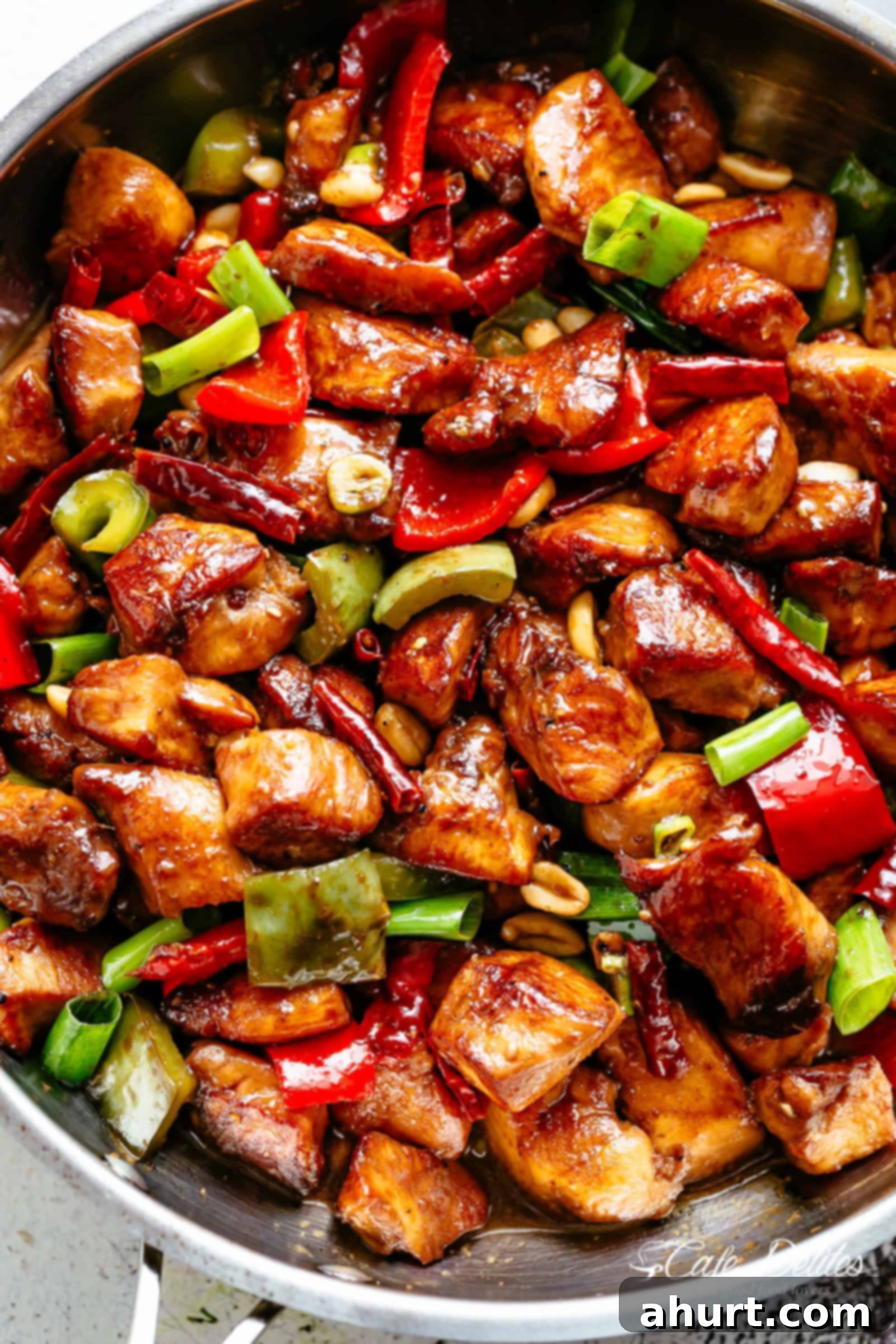The Best Authentic Kung Pao Chicken Recipe: Spicy, Sweet, and Savory Homemade Perfection
Kung Pao Chicken is a universally beloved Chinese stir-fry, renowned for its highly addictive flavor profile. This iconic dish perfectly balances salty, sweet, and spicy notes, creating a symphony for your taste buds. Imagine tender, crisp-edged chicken pieces, velvety in texture, swimming in a rich, glossy sauce, complemented by crunchy peanuts and vibrant vegetables. This recipe brings the authentic taste of your favorite Chinese restaurant right into your kitchen, promising a culinary experience that’s hard to resist!
Forget greasy takeout and elevate your weeknight dinner with this easy-to-follow Kung Pao Chicken recipe. We’ve perfected the blend of traditional techniques and accessible ingredients to ensure you achieve restaurant-quality results every time. Each bite delivers that mouthwatering combination of textures and bold flavors, making this the only Kung Pao chicken recipe you’ll ever need. Get ready to impress your family and friends with a dish that’s truly extraordinary.
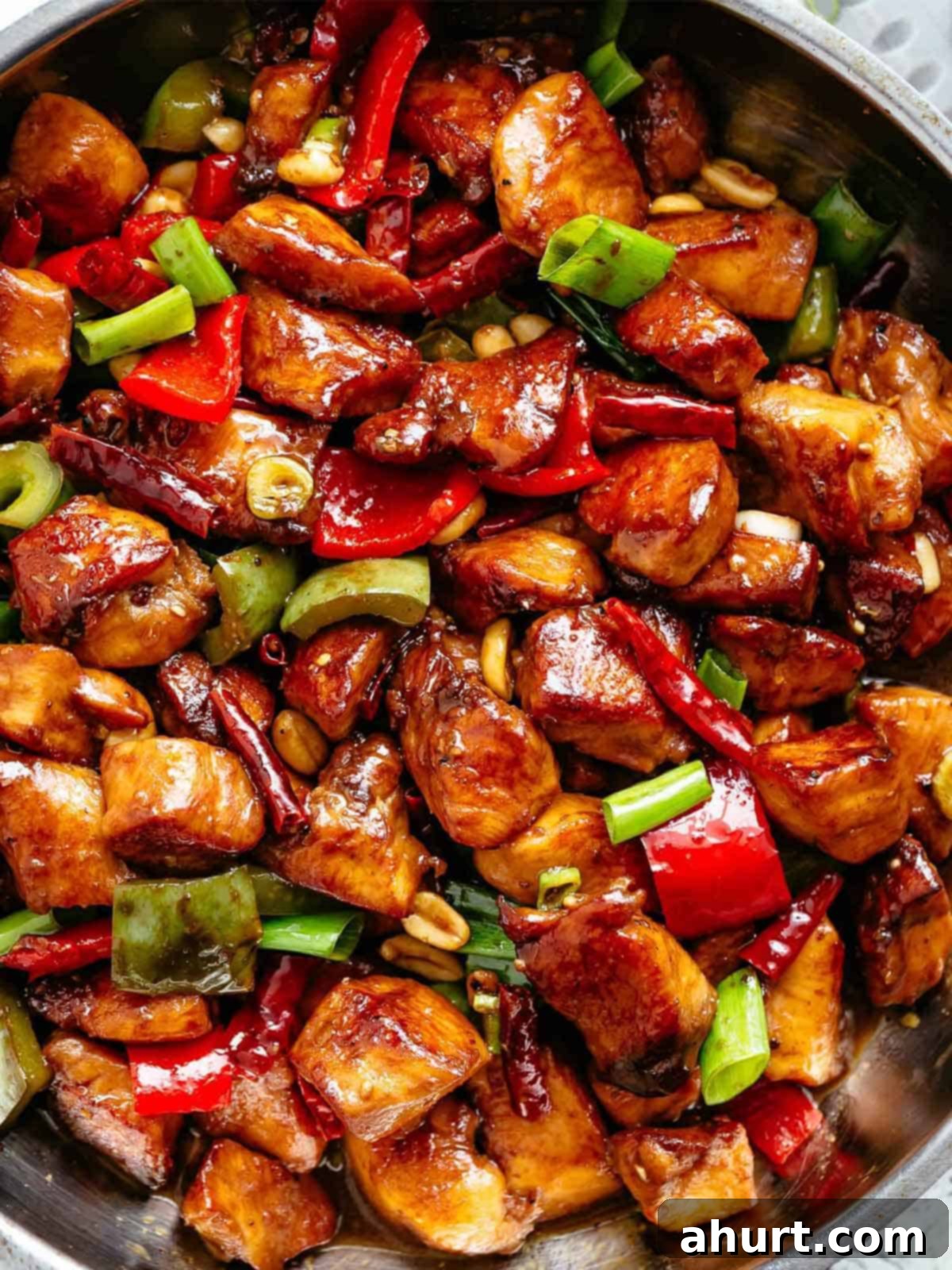
What Is Kung Pao Chicken? Unpacking This Chinese Classic
You might have explored the delightful world of Chinese cuisine with classics like Sweet and Sour Pork, savory Chicken Chow Mein, or the bright and tangy Chinese Lemon Chicken. Now, it’s time to elevate your culinary journey and meet what many consider the “final boss” of Chinese chicken dishes – Kung Pao Chicken! This particular Kung Pao Chicken recipe has been one of our most highly requested, and for good reason.
Kung Pao Chicken (Gong Bao Ji Ding) is a classic Sichuan (Szechuan) dish originating from the Sichuan province of China. It’s famously known for its distinct “ma la” flavor profile, which translates to a numbing (ma) and spicy (la) sensation, primarily derived from Sichuan peppercorns and dried chili peppers. Traditionally, this dish is a dry-stir fry, meaning it doesn’t come swimming in an excessive amount of sauce. Instead, the focus is on a concentrated burst of flavor that clings perfectly to every ingredient, creating an incredibly satisfying experience without needing a heavy, syrupy sauce.
Our rendition stays true to the authentic spirit, offering a vibrant balance of flavors that are truly explosive. You’ll find diced chicken (often velveting for tenderness), roasted peanuts for crunch, and a blend of aromatic vegetables like bell peppers, all coated in a light yet intensely flavored sauce. The beauty of this Kung Pao recipe lies in its complexity and depth, ensuring that every spoonful is packed with an exciting array of tastes and textures. Once you try this version, you’ll understand why it’s a celebrated masterpiece in Chinese gastronomy.
Key Ingredients for Authentic Kung Pao Chicken
Crafting the perfect Kung Pao Chicken requires a thoughtful selection of ingredients, each playing a vital role in achieving that signature taste and texture. Below are the essential components, divided into categories for clarity.
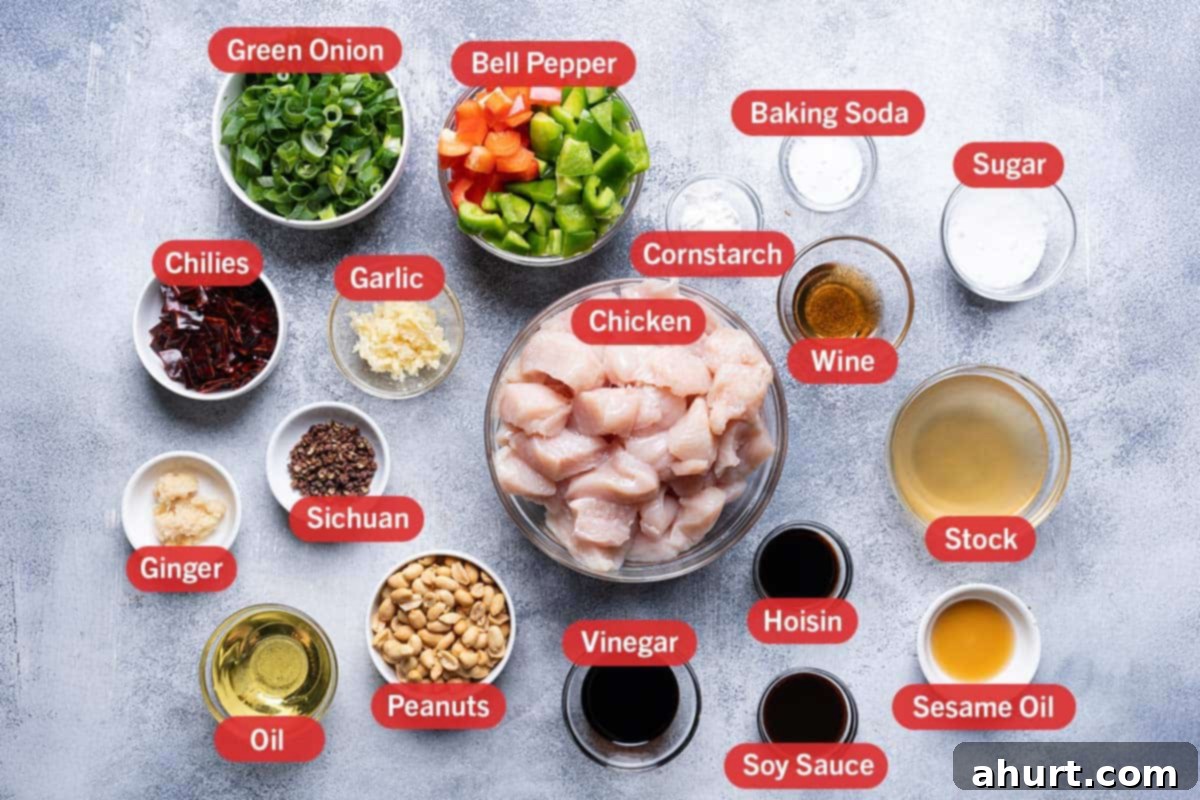
For the Velvety Chicken:
- Boneless, Skinless Chicken Breast: Cut into 1-inch cubes. You can also use chicken thighs for a juicier result, which holds up well to high-heat cooking.
- Shaoxing Wine (or Dry Sherry): Essential for authentic flavor in Chinese cooking and aids in tenderizing the chicken.
- Light Soy Sauce: Adds a savory depth to the marinade.
- Baking Soda: A crucial ingredient for the “velveting” technique, it tenderizes the chicken significantly. Don’t skip it!
- Cornstarch/Cornflour: Coats the chicken, creating a protective layer that keeps it moist and gives it a desirable texture when stir-fried.
For the Irresistible Kung Pao Sauce:
- Chicken Broth or Stock (Low Sodium): Forms the liquid base of the sauce. Low sodium is key to control the overall saltiness. Water can be used if broth is unavailable.
- Light Soy Sauce: Provides the primary salty and umami flavor. Always opt for low sodium to prevent an overly salty sauce.
- Dark Soy Sauce: Not just for color! It adds a beautiful caramel hue and a subtle, rich flavor to the sauce that light soy doesn’t provide.
- Hoisin Sauce: A sweet and savory Chinese BBQ sauce that adds depth, sweetness, and a slight thickness.
- Chinese Black Vinegar: Offers a unique tangy, slightly malty, and complex flavor that is characteristic of authentic Chinese dishes. A good quality balsamic vinegar can be a substitute, though the flavor will be slightly different.
- Chinese Shaoxing Wine (or Dry Sherry): Again, vital for that authentic Chinese aroma and flavor in the sauce. Alternatives include dry sherry, gin, or even a mix of rice wine vinegar and a pinch of sugar.
- Granulated Sugar: Balances the salty, tangy, and spicy elements of the sauce. Adjust to your preference.
- Cornstarch/Cornflour: The thickening agent that gives the Kung Pao sauce its signature silky, glossy consistency.
For the Vibrant Stir-Fry:
- Cooking Oil (Divided): Use a high smoke point oil like vegetable, canola, or peanut oil for stir-frying.
- Fresh Garlic and Ginger: The aromatic foundation of any good stir-fry, providing pungent, warming flavors.
- Red and Green Bell Peppers (or Capsicums): Add color, a slight sweetness, and a pleasant crunch. You can also include diced celery, sliced carrots, or zucchini for more vegetables.
- Dried Chilies: These are crucial for the spicy kick and a beautiful visual element. Adjust the quantity to your heat preference.
- Sichuan Peppercorns: The star of the show! Lightly toasted and ground, they deliver the unique “ma la” (numbing spicy) sensation that defines Kung Pao. Don’t omit them for an authentic experience!
- Green Onions (Scallions): Added at the end for fresh, pungent flavor and a pop of green.
- Roasted Unsalted Peanuts: Provide essential crunch and nutty flavor, a non-negotiable component of Kung Pao.
- Sesame Oil (Optional): A drizzle at the very end adds a rich, nutty aroma.
Note: For a full list of ingredients with precise measurements, please refer to the recipe card at the bottom of this page.
How To Make Kung Pao Chicken: A Step-by-Step Guide
Making restaurant-quality Kung Pao Chicken at home is easier than you think, especially when you break it down into manageable steps. The key to a successful stir-fry lies in preparation (mise en place) and cooking with high heat.
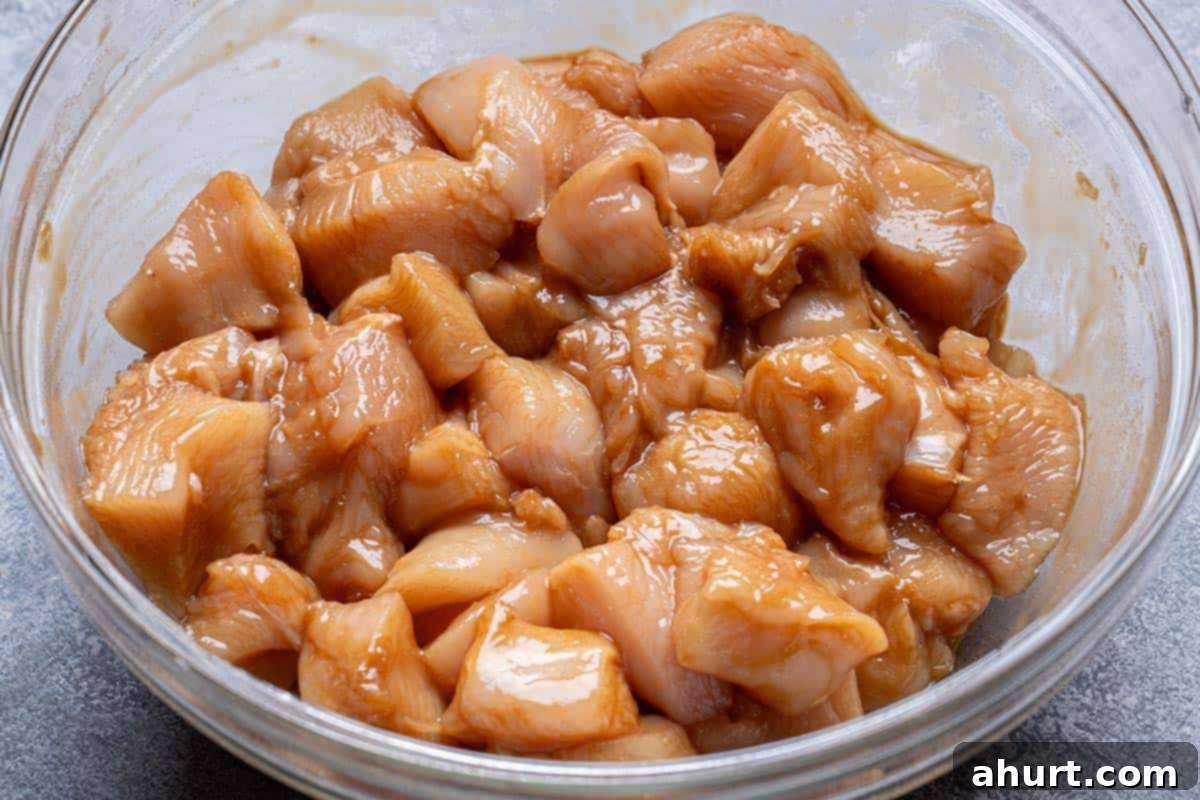
- Prepare the Chicken (Velveting): In a shallow bowl, combine your diced skinless, boneless chicken breast with Shaoxing wine (or dry sherry), light soy sauce, baking soda, and cornstarch. Mix well to ensure every piece is evenly coated. The baking soda is crucial for tenderizing, while cornstarch creates a protective barrier for moisture. Cover and marinate for at least 10 minutes, or up to 30 minutes if time allows, for maximum tenderness.
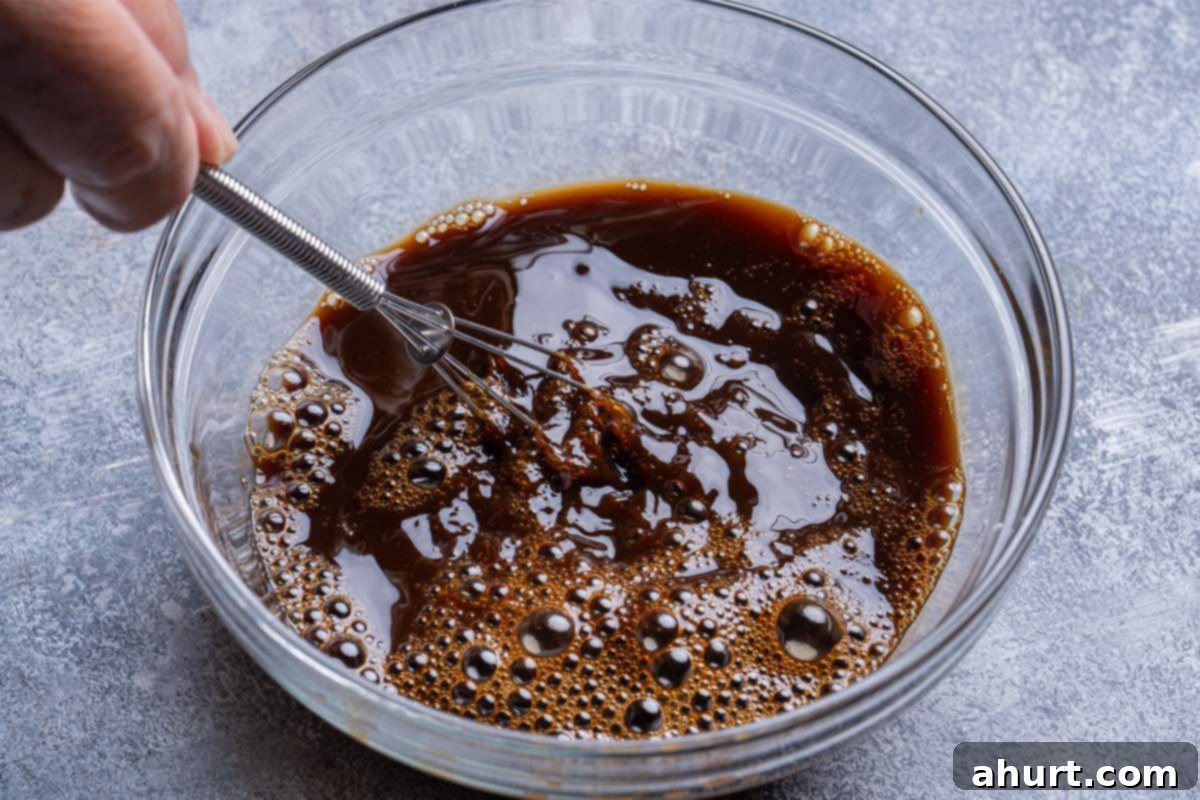
- Whisk the Sauce: In a separate bowl, whisk together the chicken stock, light soy sauce, Chinese black vinegar, Chinese Shaoxing wine (or dry sherry), dark soy sauce, hoisin sauce, sugar, and cornstarch. Whisk vigorously until the sugar completely dissolves and the mixture is smooth. Set this mixture aside; having it ready is essential for the rapid pace of stir-frying.
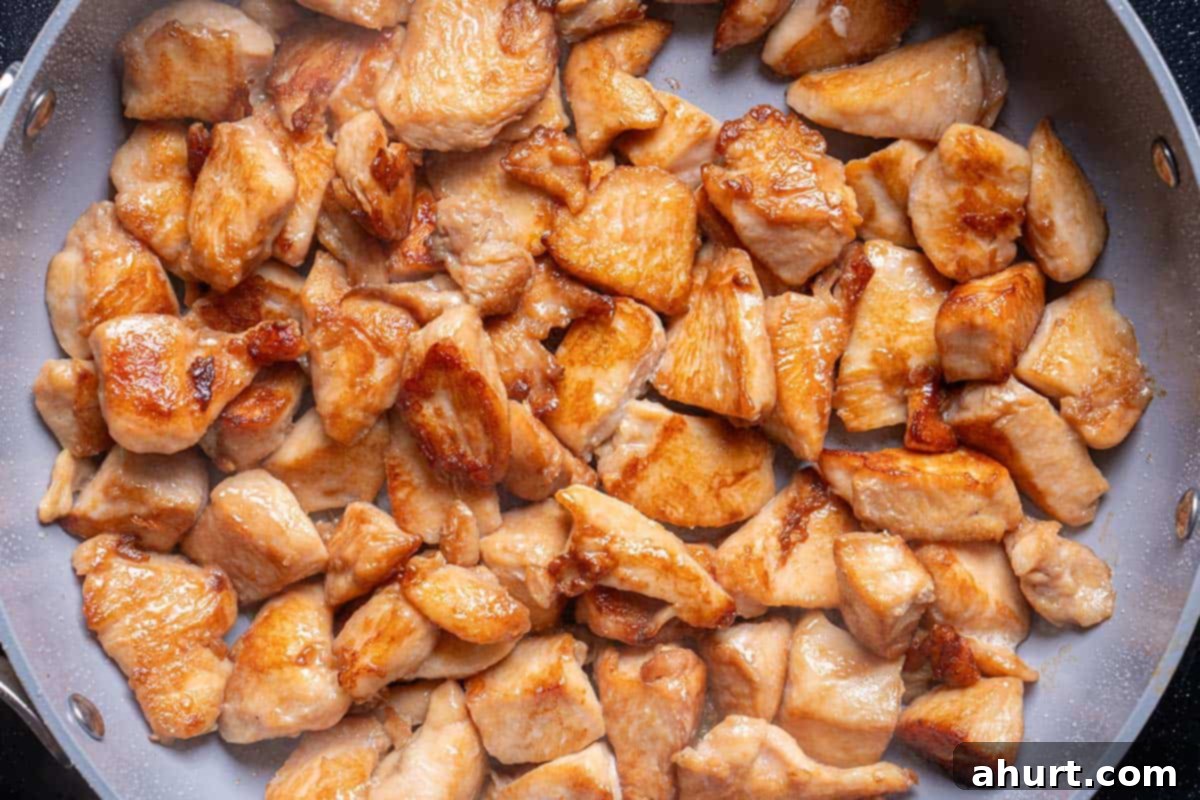
- Sear the Chicken: Heat a large skillet, wok, or deep pan over high heat. Add 2 tablespoons of cooking oil and let it get shimmering hot. Add the marinated chicken in a single layer (cook in batches if necessary to avoid overcrowding, which steams the chicken instead of searing it). Fry for 3-4 minutes, stirring occasionally, until the edges are beautifully browned and the chicken is mostly cooked through. Remove the chicken from the pan and set it aside.
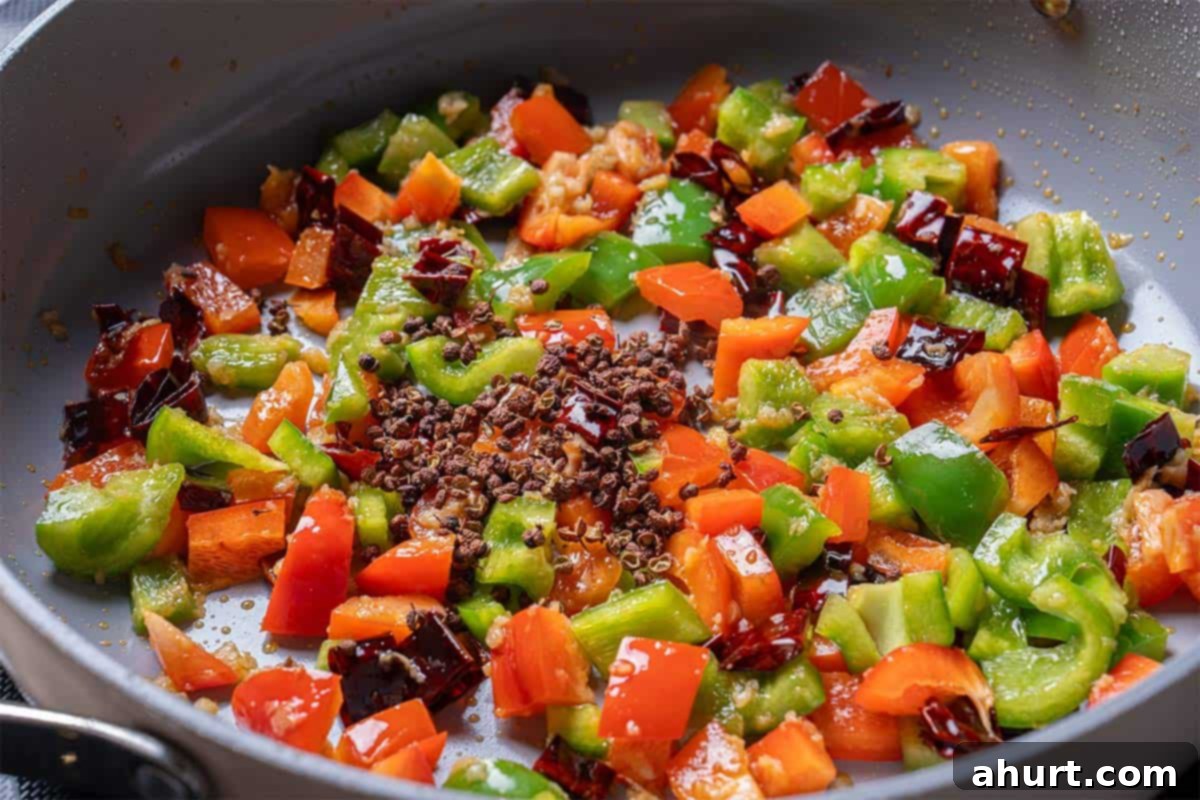
- Stir-Fry Aromatics and Spices: Add the remaining cooking oil into the same hot pan/wok. Immediately add the minced garlic, grated ginger, dried chili peppers, diced bell peppers (capsicums), and the lightly toasted and ground Sichuan peppercorns. Stir-fry rapidly for about 1 minute until fragrant. Be careful not to burn the garlic or chilies. This step is where the incredible aroma and “ma la” heat truly develop.
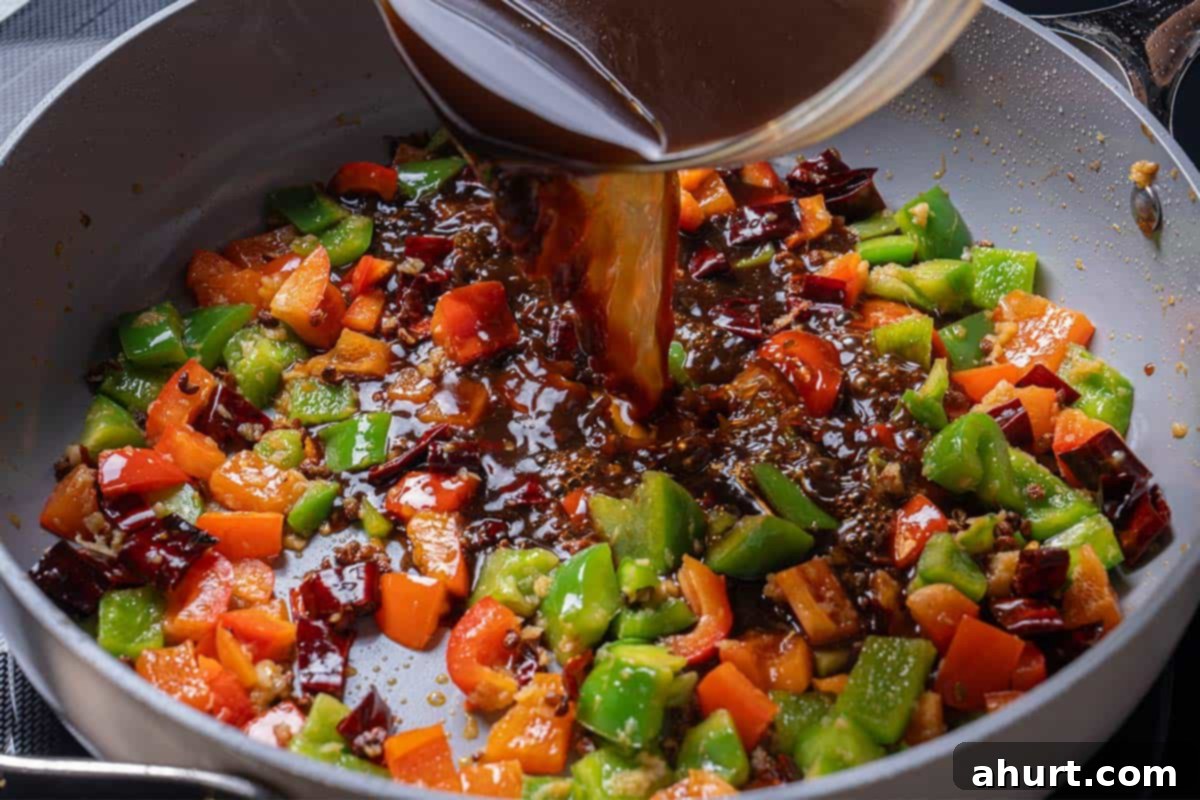
- Add the Sauce: Give your prepared sauce a quick stir one more time to ensure the cornstarch hasn’t settled. Pour the entire mixture into the pan with the aromatics. Bring the sauce to a rapid boil while continuously stirring. You’ll notice it begin to thicken almost immediately due to the cornstarch.
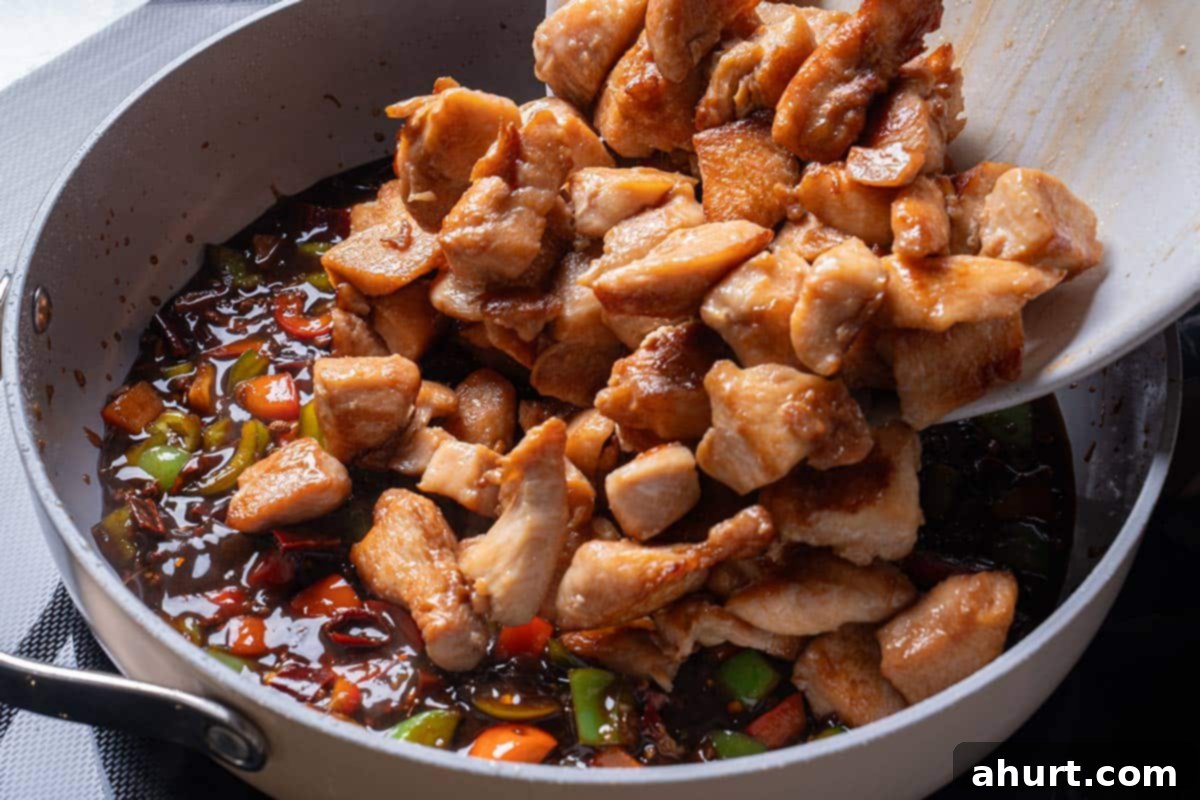
- Combine Chicken and Sauce: Once the sauce has thickened slightly to a glossy, coatable consistency, add the previously seared chicken pieces back into the pan. Toss and stir vigorously to ensure all the chicken and vegetables are thoroughly and evenly coated with the rich sauce. Continue to cook for approximately 1-2 minutes, allowing the flavors to meld and the sauce to fully adhere to the chicken.
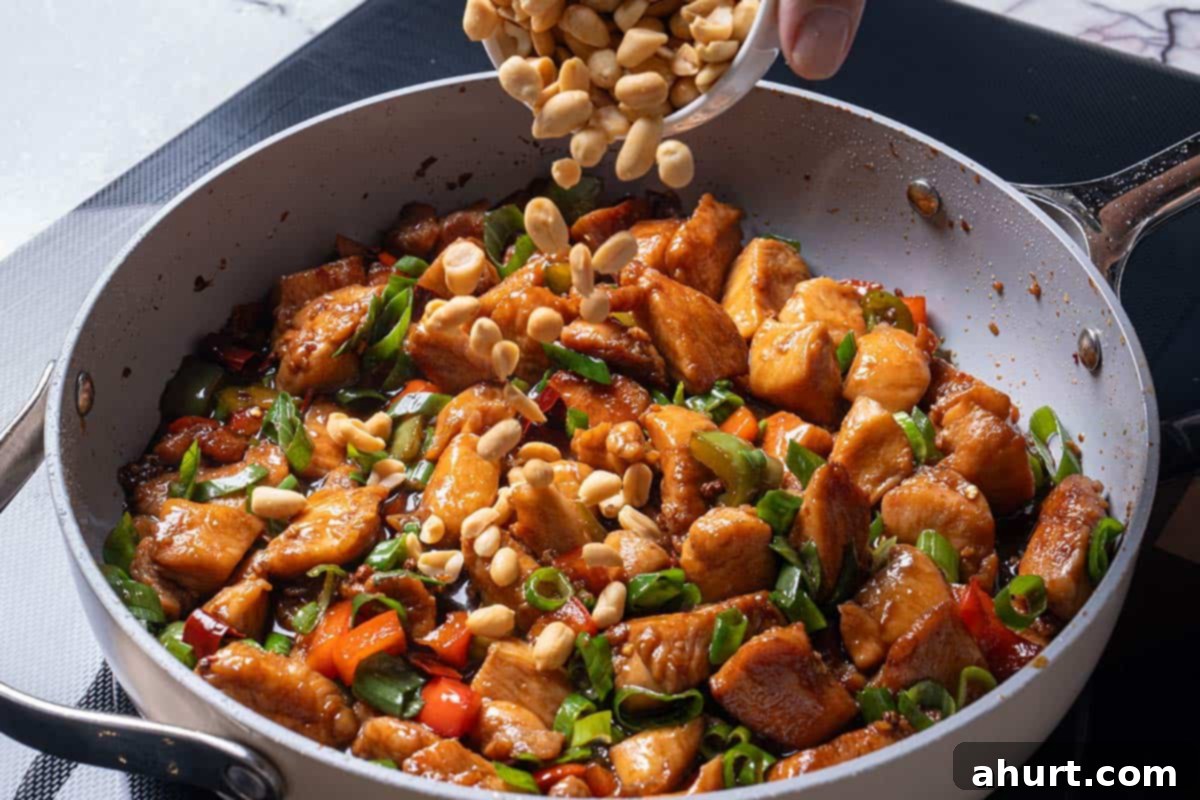
- Finishing Touches: Stir in the chopped green onions (scallions), roasted peanuts, and a dash of sesame oil (if using). Toss everything well for another 2 minutes. This brief cooking time allows the fresh flavors of the green onions to integrate and the peanuts to warm up, while the sesame oil adds a final aromatic flourish.
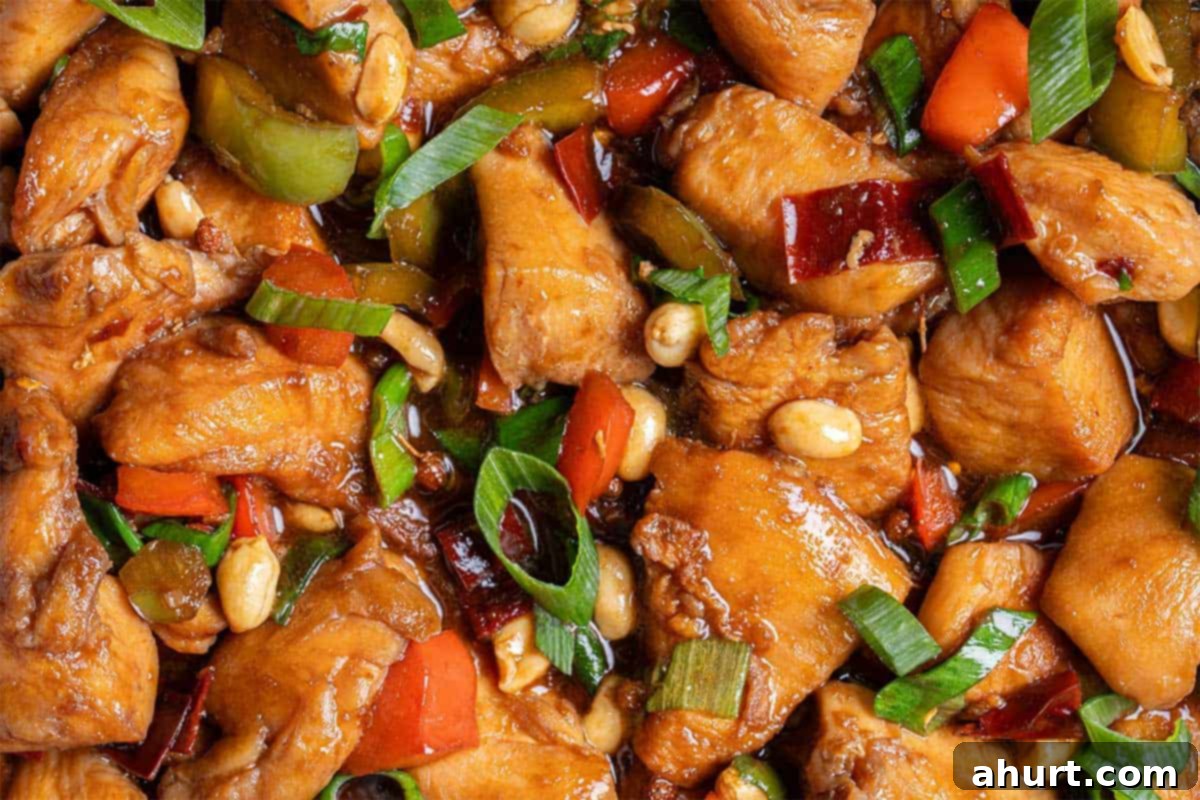
- Serve and Enjoy: Your homemade Kung Pao Chicken is best served immediately! Spoon generously over a bed of fluffy steamed white rice or flavorful fried rice to soak up every drop of that delicious, silky sauce.
For an even more satisfying meal, I highly recommend serving your freshly prepared Kung Pao Chicken over a hot bed of white rice, paired with a vibrant side of Five Minute Sugar Snap Peas or simple steamed broccoli for a complete and balanced dinner.
Recipe FAQs: Your Kung Pao Questions Answered
While Kung Pao Chicken can be made without them, Sichuan peppercorns are a signature ingredient that provides the distinctive “ma la” (numbing and spicy) sensation characteristic of authentic Sichuan cuisine. They create a tingling, almost buzzing, feeling on the tongue that is uniquely satisfying and sets Kung Pao apart. If unavailable, you can omit them, but be aware that the unique flavor profile will be altered, resulting in a dish that is simply spicy, rather than numbing-spicy. For a hint of their unique aroma without the full numbing effect, you can add a tiny amount of black peppercorns or a pinch of white peppercorns.
Velveting is a traditional Chinese cooking technique that tenderizes meat and gives it a incredibly silky, smooth texture. In this Kung Pao Chicken recipe, the chicken pieces are marinated in a mixture of cornstarch, baking soda, and Chinese wine (or alternatives like sherry, rice wine, or vinegar), along with a little soy sauce. This marinade creates a thin, protective coating around the chicken. When stir-fried, this coating seals in moisture, prevents the chicken from drying out or becoming tough, and results in exceptionally tender, flavorful chicken that has that desirable “velvet” mouthfeel. It’s a game-changer for homemade Chinese stir-fries.
The spiciness of Kung Pao Chicken can be fully adjusted to your personal preference. Our recipe uses dried chilies and Sichuan peppercorns, which deliver both heat and the unique numbing sensation. If you’re sensitive to heat, start with a smaller amount of dried chilies (e.g., 4-6 pieces) and just 1 teaspoon of ground Sichuan peppercorns. For more intense heat, you can increase the number of dried chilies and even add a pinch of red chili flakes. Always taste as you go and adjust accordingly to make it perfectly suitable for your palate.
Absolutely! While chicken breast is traditional and works wonderfully with the velveting technique, boneless, skinless chicken thighs are an excellent alternative. Chicken thighs are naturally juicier and more forgiving during high-heat stir-frying, making them a popular choice for those who prefer a richer, more succulent texture. Just ensure they are cut into similar 1-inch cubes for even cooking.
Leftover Kung Pao Chicken can be stored in an airtight container in the refrigerator for up to 3-4 days. To reheat, gently warm it in a skillet over medium heat, adding a splash of water or broth if the sauce has thickened too much. You can also microwave it, but stovetop reheating helps maintain the texture of the chicken and vegetables better.
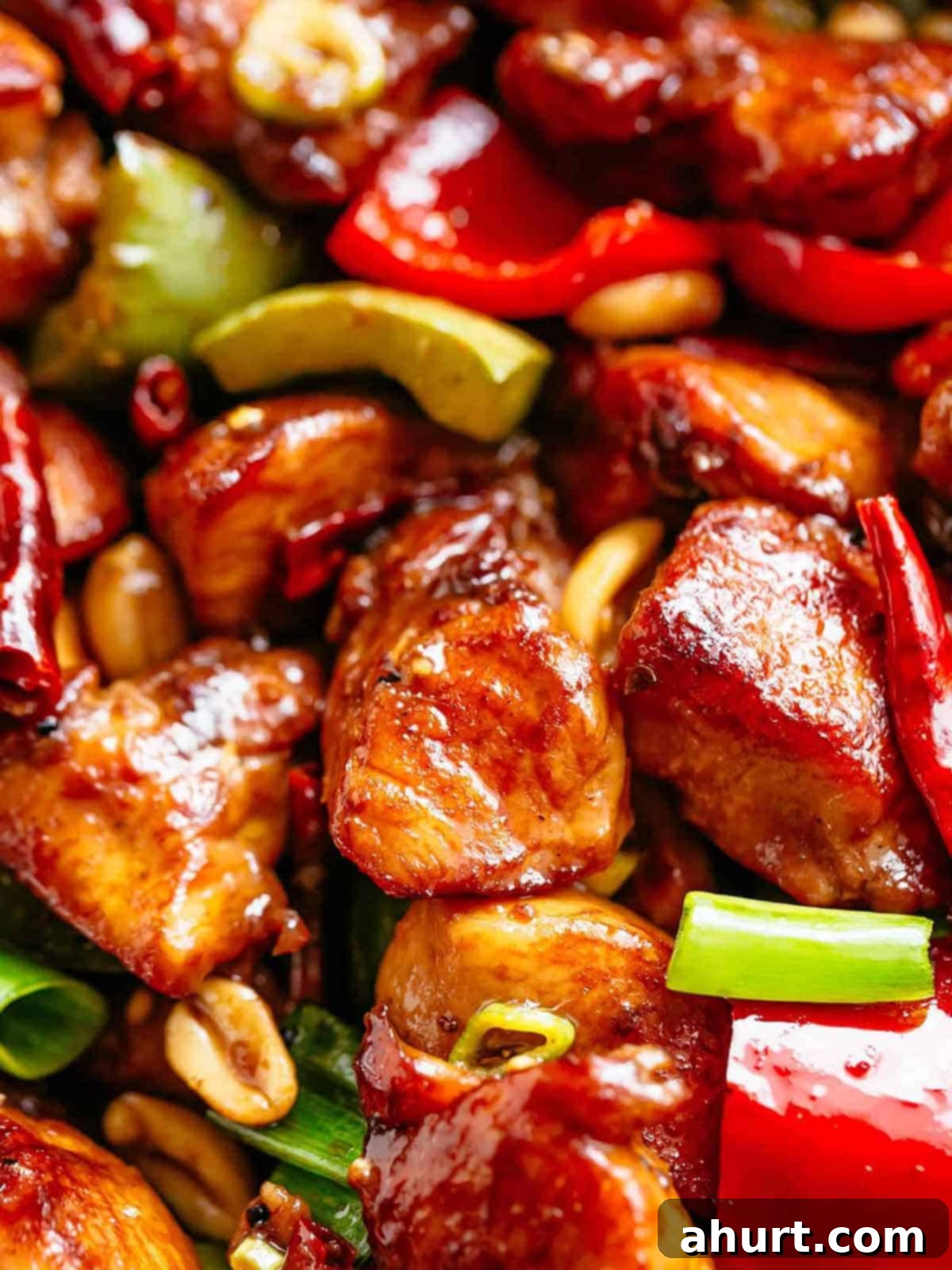
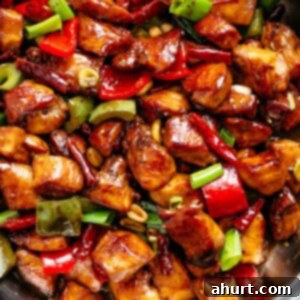
Saved
Pin
Kung Pao Chicken
Karina
10 minutes
10 minutes
20 minutes
6
people
Ingredients
Chicken (Velveting Marinade):
-
28
ounces
skinless chicken breast
boneless, cut into 1-inch cubes -
1
tablespoon
Shaoxing wine
or dry sherry -
1
tablespoon
light soy sauce -
2
teaspoons
baking soda -
1
teaspoon
cornstarch
cornflour
Kung Pao Sauce:
-
1/2
cup
low-sodium chicken stock
or broth – water can be used -
5
tablespoons
light soy sauce -
2
tablespoons
Chinese black vinegar
or substitute good-quality balsamic vinegar -
2
tablespoon
Chinese Shaoxing wine
or dry sherry -
2
teaspoon
dark soy sauce -
2
teaspoons
hoisin sauce -
2
tablespoons
sugar -
1
teaspoon
cornstarch
cornflour
Stir Fry Components:
-
4
tablespoons
cooking oil
divided -
1 1/2
tablespoons
garlic
4-6 cloves, minced -
1
tablespoon
ginger
grated -
1/2
red bell pepper
seeded and diced -
1/2
green bell pepper
seeded and diced -
8-10
dried chilies
cut into ½-inch pieces (adjust to taste) -
1
tablespoon
Sichuan peppercorns
lightly toasted and ground -
4
green onion
scallion stems, cut into 1-inch pieces -
1/2
cup
roasted unsalted peanuts -
2
teaspoons
sesame oil
optional
Instructions
-
1. Marinate the Chicken: In a shallow bowl, combine the diced chicken with Shaoxing wine, light soy sauce, baking soda, and cornstarch. Mix thoroughly until all chicken pieces are well coated. Cover the bowl and let it marinate for at least 10 minutes, or up to 30 minutes for optimal tenderization.
-
2. Prepare the Sauce: In a separate medium bowl, whisk together all the sauce ingredients: chicken stock, light soy sauce, Chinese black vinegar, Chinese Shaoxing wine, dark soy sauce, hoisin sauce, sugar, and cornstarch. Whisk until the sugar has completely dissolved and the mixture is smooth. Set aside.
-
3. Sear the Chicken: Heat a large skillet, wok, or deep pan over high heat until it’s shimmering. Add 2 tablespoons of cooking oil. Once hot, add the marinated chicken in a single layer (cook in two batches if necessary to avoid overcrowding). Fry for 3-4 minutes, stirring occasionally, until the chicken edges are browned and it’s mostly cooked through. Remove the chicken from the pan and set it aside.
-
4. Stir-Fry Aromatics & Spices: Add the remaining 2 tablespoons of cooking oil to the same pan/wok. Add the minced garlic, grated ginger, dried chilies, diced red and green bell peppers, and the ground Sichuan peppercorns. Stir-fry rapidly for 1 minute until fragrant and the bell peppers start to soften slightly.
-
5. Add the Sauce: Give the prepared sauce a quick final whisk. Pour the entire sauce mixture into the pan with the aromatics and bring it to a boil, stirring continuously. The sauce will begin to thicken as it heats up.
-
6. Combine Chicken & Sauce: Once the sauce has thickened slightly to a glossy consistency, add the seared chicken back into the pan/wok. Toss and mix all the ingredients thoroughly through the sauce until the chicken is evenly coated and the sauce has fully thickened and clings to the chicken (this should take about 2 minutes).
-
7. Finish with Freshness: Stir in the chopped green onions, roasted unsalted peanuts, and a drizzle of sesame oil (if using). Toss everything well and continue to cook for a further 2 minutes, allowing all the flavors to infuse beautifully.
-
8. Serve Immediately: Your delicious homemade Kung Pao Chicken is ready! Serve it piping hot over steamed white rice or your favorite fried rice. Enjoy!
Notes
*For those sensitive to spice or preferring a milder sauce, begin with 1 teaspoon of ground Sichuan peppercorns and a reduced number of dried chilies. You can always add more during the stir-fry process to achieve your desired level of “ma la” and heat.
*Mise en Place is Key: In stir-frying, everything cooks very quickly. Make sure all your ingredients are prepped, measured, and laid out near your stove before you start cooking. This ensures a smooth and stress-free cooking process.
*High Heat: Use high heat for searing the chicken and stir-frying the aromatics and vegetables. This creates the desirable smoky ‘wok hei’ flavor and prevents ingredients from steaming.
Nutrition
Calories:
381
kcal
|
Carbohydrates:
14
g
|
Protein:
34
g
|
Fat:
21
g
|
Saturated Fat:
3
g
|
Polyunsaturated Fat:
5
g
|
Monounsaturated Fat:
11
g
|
Trans Fat:
0.1
g
|
Cholesterol:
85
mg
|
Sodium:
1.667
mg
|
Potassium:
737
mg
|
Fiber:
2
g
|
Sugar:
6
g
|
Vitamin A:
653
IU
|
Vitamin C:
25
mg
|
Calcium:
39
mg
|
Iron:
2
mg
Nutrition information is automatically calculated and should only be used as an approximation. Actual values may vary based on specific ingredients and preparation methods.
Tried this? Leave a comment below!
